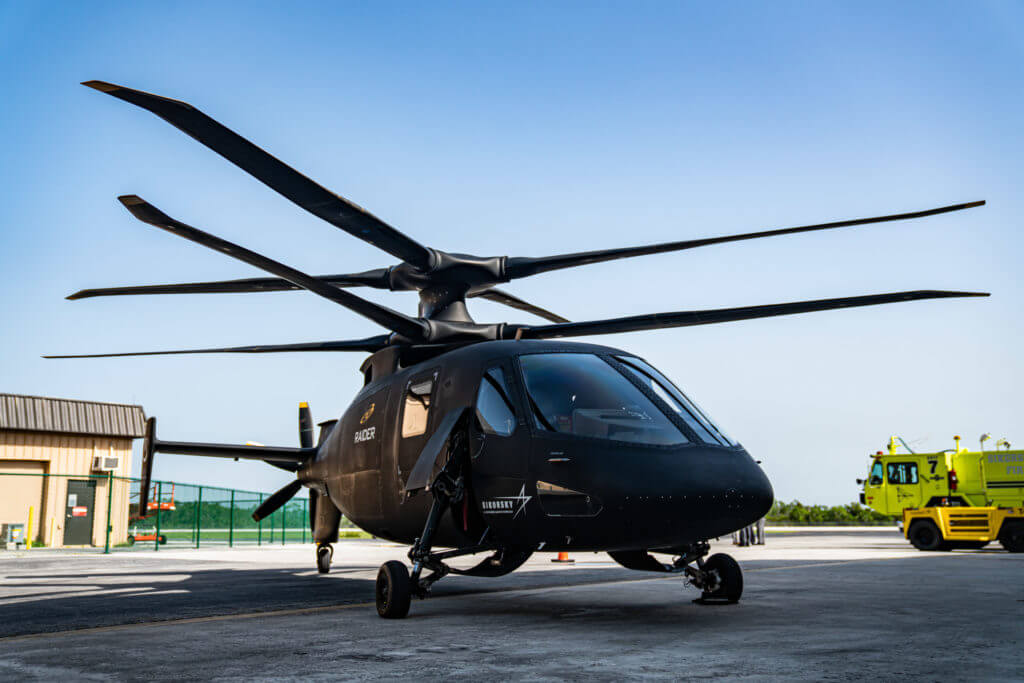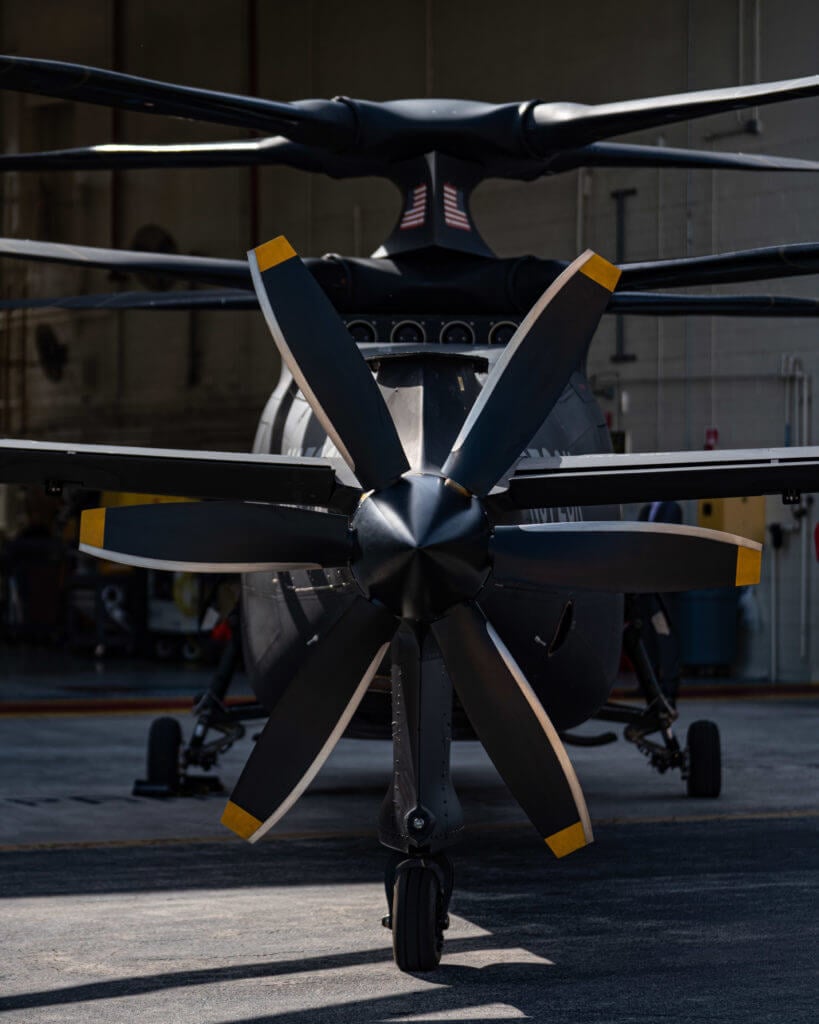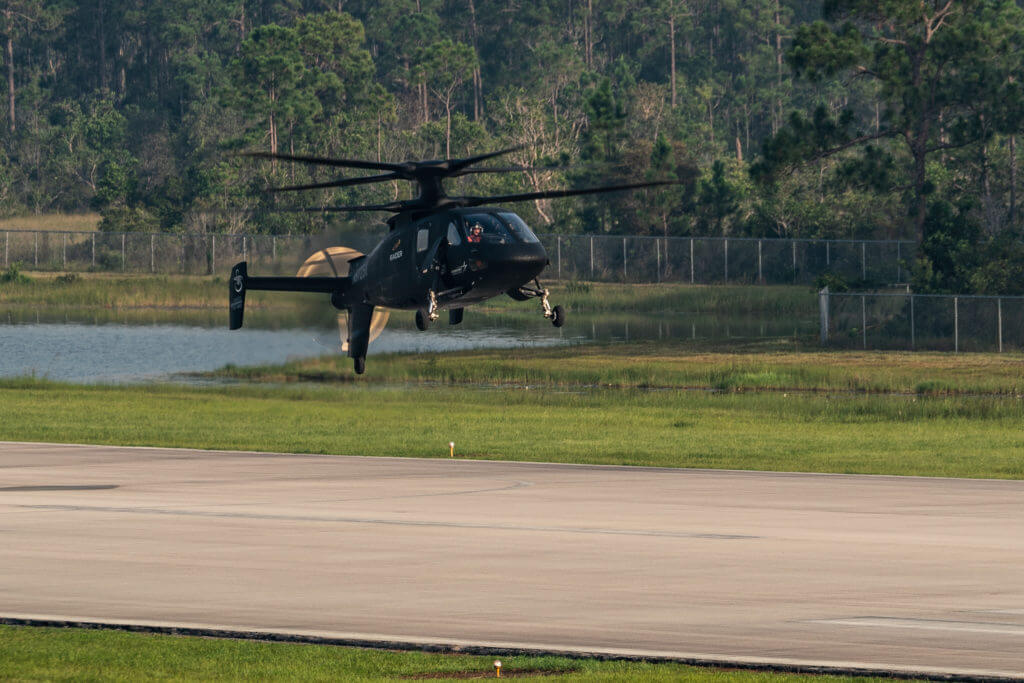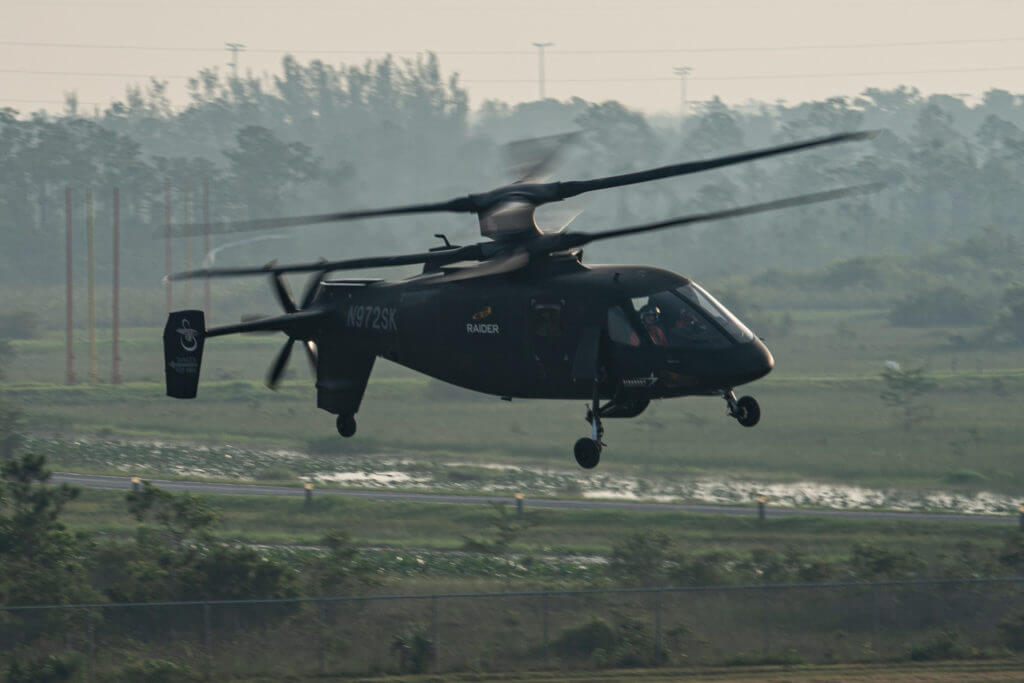During a 20-minute test flight of the prototype S-97 Raider at Sikorsky’s West Palm Beach, Florida, facility — conducted in front of four journalists in the first such public demonstration — the unconventional coaxial-rotor aircraft performed routines that would make any helicopter pilot jealous.

For instance, the single-engine Raider, which Sikorsky is using as a testbed as it develops its entry for the U.S. Army’s Future Attack Reconnaissance Aircraft (FARA) competition, used reverse pitch on its rear propeller to maintain a nose-down attitude in a steady hover — as if targeting weapons or sensors to the ground, searching for injured hikers, or inspecting a landing zone. It’s a move no other helicopter can execute without drifting. Then it maneuvered briskly and perfectly above the runway, performing multiple tight patterns with an agility made possible by its rigid, stacked rotors, which rotate in opposition to each other, counteracting torque and negating the need for a tail rotor. Most other helicopters, with their hinged, flexing blades, can’t come close to that sort of precision.
Test pilot Christiaan Corry described the S-97 Raider’s performance characteristics in a way that seemed to suggest that he and his program colleague, Bill Fell, who commanded the flight, might actually have the best job in the world. “It really handles like a sportscar,” Corry said. “We don’t have an inverted oil or fuel system in this aircraft, but aerodynamically, it could fly inverted all day long. We demonstrated that in the simulator, and are proving every day that Raider can do so much in the air. The rotor system acts like a wing, and we can do these aerobatic maneuvers that just aren’t things helicopters could ever do before.”
The test seemed to validate that point. As the crew cycled through its test card on that characteristically sweltering Florida morning, we also saw Raider perform turns in half the distance of other helicopters and accelerate and brake with the fuselage completely level, thanks to the rear propeller that sits in place of the tail rotor. Whereas conventional helicopters must tilt their main rotor discs forward in order to accelerate — and backward to slow down — in the Raider, the rear propeller can be used to push the helicopter to faster speeds and also, with the blade’s pitch reversed, practically stop it on a dime. Engaging reverse pitch while simultaneously tilting the main rotors forward enables the nose-down hover. The Raider can also hover with its nose pointed skyward, by tilting the main rotors aft while generating forward thrust with the prop.

Of course, this enhanced maneuverability is actually the lesser of the payoffs from the coaxial main rotors and rear prop. The main one is significantly faster forward flight. Developed from Sikorsky’s Advancing Blade Concept, the compound design’s dual rotors neutralize the stall tendency exhibited by retreating rotor blades in conventional helicopters as speed increases. Because that instability effectively limits top speed, a helicopter with this design can fly far faster than any other. Raider’s predecessor, the X2 experimental helicopter that flew between 2008 and 2011, reached 250 knots, and Raider, which first flew in 2015, has hit 207 knots so far. (Raider’s successor is the larger and faster SB-1 Defiant being developed in partnership with Boeing through the Army’s Joint Multi-Role Technology Demonstrator program. It first flew in March.)
During the demonstration in front of the media, Fell and Corry streaked past us at 190 knots on multiple passes, with Raider behaving more like an airplane than a rotorcraft — and for that matter, sounding more like one, too. (In fact, it had a distinctly warbird-like vibe. Think Spitfire, not Black Hawk.) Although this was short of the planned 200 knots due to issues with the vibration control software, it was still staggeringly fast for a rotorcraft.
Raider’s bag of tricks goes even deeper. It can dive onto a target — also airplane-style — while using reverse pitch on the rear propeller to slow and extend the dive. The pilots can also disengage the prop and slow down the main rotors, generating a “quiet mode” when a dash of stealth is called for. Sikorsky demonstrated both of these, as well. In sum, all of Raider’s capabilities add up to a product that Chris Van Buiten, vice president of Sikorsky Innovations, feels confident meets or exceeds the Army’s requirements. “It’s well beyond the capabilities of the current fleet,” Van Buiten said. “The threat environment going in and out of combat will become more intense, so you need to be fast, maneuverable, and agile, and you need low-altitude flight so you can use the clutter to mask your signal-to-noise ratio.”

As Sikorsky’s senior experimental test pilot, Fell said Raider’s acceleration and maneuverability strengths will represent a massive upgrade to pilots. “When I was in Army flight school, we had this teetering rotor system that has relatively low control power,” he said. “Then you go to a Black Hawk or an Apache with its articulated rotor system, and there’s a jump in control power, but also a lag that the system creates between putting the input in and getting the aerodynamic response. But here, with the rigid rotor, it’s pretty instantaneous. The jump is just as big as it is going between teetering and articulated.”
He cited not just the demonstration we observed, but the facility’s ADS-33 slalom course, used to evaluate handling qualities. There, pilots can easily gauge their progress due to the visual cues of the course and the scripted parameters developed for the challenge. “What I found in this aircraft, even with no altitude hold and no position hold, I was able to do it better in this machine than in other aircraft with all of those extra features,” Fell said. “Because the response is so crisp and so instantaneous, you can just go up to exactly that spot. You can put it exactly where you want it.”
Of course, there remain challenges for the program — understanding everything from maintenance costs and reliability, to fully grasping the new configuration’s quirks and risks. The program suffered a setback in this area in 2017 when the first test model sustained a hard landing on the runway in Florida after the upper and lower counter-rotating blades made contact. Van Buiten said it was caused by a software problem that increased the sensitivity of the controls and led to excessive roll oscillations, and it would have impacted any helicopter equally. He noted that it has been fixed thoroughly enough to ensure no similar accidents can happen again, and Fell emphasized that the physics of that incident are “well-understood.”

The crew certainly didn’t seem shy about testing the maneuverability of the aircraft during the demonstration, which of course shows their presumed confidence in the fix. But the routine highlighted not just the far end of combat agility; it also showed off the aircraft’s more subtle performance characteristics. Level acceleration and deceleration, for example, could make for smoother and more comfortable departures and approaches, especially if the helicopter is flying passengers or VIPs, as Sikorsky is indeed positioning it to do.
On the other hand, Fell has no problem doing things the old-fashioned way, even in the Raider. “When I go to leave a landing zone, if I push the nose over and accelerate out like a helicopter, those big rotors take a bigger bite of the air than the prop ever could,” Fell said. “So I really think the best way to accelerate out of that landing zone is still to dip the nose, use the rotor, and supplement it with the with the propeller.”
To learn more about the Raider, visit our Q-and-A with Bill Fell on our Facebook page.










Very very nice…advances in rotorcraft are few and far between…this one seems to have manys pros and promotes rotorcraft in general…kudos Sikorsky.
So can this aircraft perform negative g’s like the MBB Bo 105? If it is more maneuverable than the Boeing Apache than it will do fine.
A Black Hawk is more maneuverable than an Apache. This is a demonstrated fact.
Negative or less than 1 G? Every Sikorsky aircraft I worked on was flight tested doing push overs to less than 1G.
That’s good to know how it progressing.